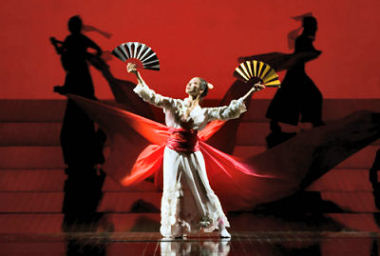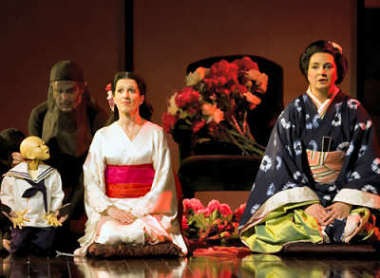|
Editor:
Marc Bridle
Webmaster: Len Mullenger
|
Seen
and Heard Opera Review Mary Plazas: Madam Butterfly Gwyn Hughes Jones: Pinkerton Jean Rigby: Suzuki Christopher Purves: Sharpless Alan Oke: Goro Julian Tovey: Bonze Mark Stone: Yamadori Stephanie Marshall: Kate Pinkerton Blind Summit Theatre. Anthony Minghella (director) Carolyn Choa (choreographer) Set designer: Michael Levine Costume Designer: Han Feng David
Parry (conductor) Conceptually, these remarkable insights might have made for a penetrating production that challenges the sentimentality that lurks behind the opera. Indeed, it could have worked had the performances been as inspired as the basic idea. What has made the opera such a perennial is the unconditional emotion of the music, its flamboyant exaggeration of romantic excess. Kitsch some of its ideas may be, such as the regular repeats of national anthems, but itís loved for its unequivocally over the top lushness. Part of the problem lies in the English translation. Sometimes itís good, as when » un facile vangelo becomes ďWhat a facile little gospelĒ. But the change from a language rich in vowels to one with consonants isnít always happy. Lines like piccolo Iddio! Amore, amore mio, fior di giglio e di rosa just donít have the same roundness. On the other hand, though, thereís no place for linguistic snobbery in an opera that communicates feelings as fluently as this. The real weakness was the pinched quality of much of the singing and acting, quite the opposite of the overblown sentiment the music calls for. Mary Plazas in some ways fits the image of a childlike Madam Butterfly rather well as sheís physically tiny. When she is embraced by the very big Gwyn Hughes Jones, as Pinkerton, it really drives home the fact that this is the story of a child being sexually exploited. Itís repellent, and meant to be. It works fine as theatre, because the text implies that the girl is already emotionally disturbed even before she is used by Pinkerton. It makes her delusional behaviour explicable Ė this isnít love, itís obsession. Anyone who has seen Japanese horror movies Takashi Miikeís Audition or Hideo Nakataís Ring will be familiar with the idea of traumatized young women who are quite capable of hiding insanity under a demure mask. Perhaps the fault is Pucciniís, for his music in Act III portrays Butterfly as warm and womanly, contradicting what he tells us about her in Act I. But Plazas does not have the vocal heft to carry off either characterization. Sheís pleasant enough but thin in the upper register. Her big crescendos donít overwhelm as they can with singers like Moffo, Scotto, or even Te Kanawa. It would have been possible to miss One fine day if you werenít expecting it. In this production where her childlike quality is stressed, it might work as plain theatre, but this music without fullness just doesnít work. Rigby, as Suzuki, came across as a much deeper personality, as did Purves as Sharpless. Purvesí acting skills projected down to earth common sense, reality countering the illusions not only of Butterfly but of Pinkerton himself, and their sham marriage. He therefore becomes the truly pivotal counterbalance in this production, where truth and delusion are emphasized. In the relatively minor role of Yamadori, Mark Stone, too, was outstanding. What will be remembered, however, is the attempt to inject Bunraku into heady Italianate opera. The two traditions make useful contrasts, but the idea of the infant Sorrow as a puppet with a skull for a head is just too much. These days Health and Safety and child protection laws preclude having real children in demanding roles like this, late at night. Perhaps Minghella is telling us that the child is just another puppet in a wider game? In the opera, his role is to be the innocent, loving being who inspires love from everyone, even in Mrs Pinkerton. Why should he be portrayed as an ugly miscreant? Are mixed race people somehow not human? The sudden transformation of the ninjas into puppeteers comes too late and detracts from the purity and naturalness that a real child would represent. Conversely, Minghella confirms how important this non-speaking part is to the whole story. The boy isnít a puppet, but represents the reality and human truth which contradicts the sordid arrangements that brought him forth. All this, however, would seem a quibble, for Madam Butterfly is primarily an opera to be enjoyed without necessarily taxing an audience intellectually. This production scored very well indeed as spectacle, the costumes in particular, with their neon Shanghai Tang quirkiness. This is a production that can be thoroughly involving for its dramatic gloss, and why not? Itís much better for the future of opera that productions like this wean audiences beyond bland West End musicals. Anne Ozorio
Back to the Top Back to the Index Page |
| ||
|
||||




